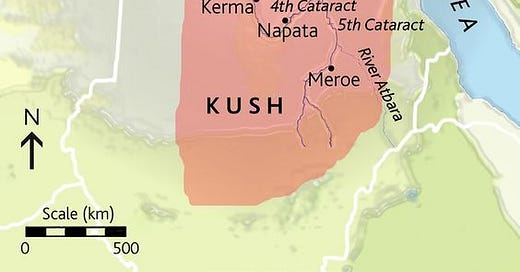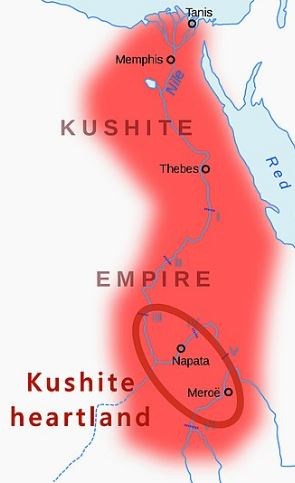Welcome to the single most confusing name in all of biblical historicity. It is impossible to not mention Seba along with his brothers, Sabtah and Sabtecah, and from those names you can clearly see how confusing identification along etymological grounds becomes. Even worse, another of Cush’s son’s named ‘Raamah’ has a son also named “Sheba”, possibly giving rise to the biblical “Queen of Sheba” and the competing debates for her origin. As a result of this debate, any discussion around “Sheba”, or “Seba”, or any of these children becomes fraught with propagandistic value for various communities. Even worse still is the fact there are two other Shebas! One of them is the son of Joktan, in the lineage of Shem, and another ‘Shemite’ Sheba, who is the son of Jokshan, the son of Abraham no less! This son of Abraham, Jokshan, is actually the father of two sons, both named Sheba and Dedan, identical to the sons of Raamah making this whole picture almost inconceivably difficult.
Let’s pull it back for a moment, and return to Seba, who was a certified son of Cush, and examine the actual Hebrew name. In Hebrew the name is “סְבָא֙” which uses a Samekh, a letter that makes a “Ss” sound. The vowel under the Samekh is pronounced with a “ee” sound, making the first sound “Si”. The second sound is “Bah” or possibly “Vah” as the Bais letter is often pronounced Vais. Thus the name for this son is “Siba, or “Seva”. For the name “Sheba”, son of Raamah (as well sa the other two Shebas, including the Queen - we have the Hebrew word “שְׁבָ֥א” - with the only difference being the first letter “Shin” instead of “Samekh”. As the name Shin implied, the Shin is pronounced with a “Sh” sound, contrasting starkly with “Seba”.
Both Sabtah and Sabtecah do use the Samekh, but this is less confusing when you understand that these are brothers of Seba, while the Sheba’s mentions are all great, great grandsons of Noah, and not meant as full nations, or kingdoms unto themselves, but more like tribes, regions and cities. With this etymological understanding we can begin our search for possible locations, or regions, associated with Seba.
Located south of Kush was the region of Butana, a mostly arid region of desert originally called the “Island of Meroe” in many ancient sources. Butana would traditionally incorporate the region at the confluence of the Nile and Atbara rivers - the first major tributary to the Nile flowing out of Ethiopia - and extend as far south as Khartoum until reaching the fertile wetlands of Gezira. Meroe not only comprised the major city of Meroe, but also the nearby sites of Musawwarat es-Sufra and Naqa.
While the previously mentioned Kingdom of Kush did control the majority of Egypt while it’s capital was centered on Napata, up until the reign of Taharqa; the later Kushite’s moved their capital to Meroe, having a second wind in the south. We could call this later “Taharqan period” separate from the earlier period, and a later center of power. In this period a second language called the Meroitic language existed1, indicating a separate ethnogenesis for this later Kingdom. This Meroetic differed from the Egyptian used in the earlier period and is more closely related to the Nubian languages, giving an indication that Meroe was certainly Nubian.
According to Herodotus - who is sometimes difficult to believe - he calls it “a great city...said to be the mother city of the other Ethiopians”2 clearly indicating Meroe, separate from Napata, had its own ethnic grouping despite both being “Upper Kush”. As implied by Herodotus, the Greeks referred to Meroe, and Kush, as “Aethiopia”, even though modern Ethiopia is much further south. It is unclear if Ethiopia in this record ALSO includes “modern ethiopia” or if it just refers to Nubia and Kush.
Some scholars believe “Meroetic” falls under the “Cushitic” language family, which comprises most of the Horn of Africa, and much of Ethiopia, with pockets in Sudan and Egypt on the coast. However, these “Cushitics” are not the same as the people of Meroe, as indicated by speakers of Cushitic having very little similarity to anything found in Meroitic. Instead, Meroitic is likely either a lost Afroasiatic language or part of the separate “Nilo-Saharan” language grouping. Either way it is clear that Seba here represents a sub people of Kush, and in this case the “First son of Kush”, which wouldn’t make sense as Meroe, the second location of the Kush empire. Seba would make more sense as the first kingdom of Upper Kush, centered around Napata, but still doesn’t make that much sense due to both of these cities being centers of power only in 800 BCE, and later in the region's periodization.
While a tentative reference, in Isaiah 45:14 it mentions Cush and the “Sabeans”, however the term is Sabean only in English, and the Hebrew word is “Se-ba-im” indicating a plurality of Seba. In the reference God says:
"The toil of Egypt and the merchandise of Cush and the Sabeans, men of stature, shall come over to you and shall be yours; they shall follow you; they shall come over in chains, and they shall prostrate themselves before you, they shall pray to you, "Only in you is God and there is no other god.”
It is completely unclear if these Sabaim are the same as “Sabaeans” which are a South Arabian tribe, but I would posit they are separate groups. Of note is that these “Sebaim” are “men of stature”, and that they will come over “in chains”, prostrating themselves like servants would before a king, something unlikely of the actual “Sabaeans”. Being that in the reference a lineage is given, “The toil of egypt” meaning the work of egypt, which creates the “merchandise of Cush”, who begat Seba, shall be the ones coming. Whether or not this is a direct reference to African slavery is up for debate, and would be highly contentious3, but it is fairly clear these Sebaim are definitely Black Africans.
The most crucial fact about Meroe is potentially that “Meroe” was not actually the original term for the city. According to Josephus, Persian King Cambyses renamed the city to Meroe in honor of his sister. This implied the name of the city was only Meroe in later, post Persian periods, and prior to 500 BCE the city had a separate name. Accordingly, the original name of the city was “Saba”, named as such after the reported founder of the city.4 This may lend credence to the supposed “Alexander effect” where city founders initiate the planning of multiple cities in their home region. Supporting this theory is that fact both Strabo and Ptolemy's map mention a place in the Sudan, along the southern parts of the White Nile as Sube, a likely derivation from Saba.
Leading credence to this theory of Meroe=Saba is a Jewish oral tradition that claims Moses in his youth led an Egyptian military expedition south into Kush, all the way up to Meroe which in those days was called “Saba”. This same story relates that the successful siege of the city was only accomplished after the King’s daughter agreed to deliver the city to Moses, and swore an oath to marry moses.5 This story may be a later attempt to explain Moses’s “Cushite Wife” in the Bible, or may be a legitimate explanation for his wife, but either way there is an association between Moses and Cush, helping attest to the closeness of Mizraim and Cush in this period.
However this identification of Seba with Meroe - the kingdom - wouldn’t exactly fit, as Meroe was a much later Kingdom centered around the region called “Upper Nubia”. While Meroe did have a strong Kerma identity, it was also much more influenced by the south than earlier Kushite empires. Realistically, Meroe and Napata both extend from the earlier Kerma culture, which created a sizable Kingdom rivaling Egypt by the year 2000 BCE, and posing a major threat on the southern border.6 However their actual ethnic identity was starkly different from the earlier Pharaohs. We can thus say that the later Kushites, in the period of the later Meroitic Kingdom of “Kush'’ are the Upper Kushites, while the ‘Lower Kushites’ may represent a separate people.
Ultimately all of these Kingdoms are the sons of Cush. The Lower Nubian Kermites, as well as the Upper Nubian Naptans, and Meroetics. We can thus tentatively place “Seba”, the first son of Cush, as the initial phase of the Cushite Kingdoms coming from Upper Nubia, rather than the first “Cush” who would represent the more northern influenced dynasties. Who is Seba? Is it the name of a founder, a city, or even a god? When, or how this Seba founded “Saba” or “Soba” - or if he even did - is still unclear and requires more archeology. Somewhere between both Saba and Soba likely contains the ethnic origin for the “Sebaite” peoples.
So far what we can identify is that “Cush” had a variety of ethnic groups, part of different language families. From the Kermites who eventually push south, and form Napata and Meroe, to the traditional “Black african” Nilotics whose oral traditions place them around the confluence of Niles. Whether the Kermites are the reason Nilotics were forced south is unclear, but the area included others such as the ‘Cushitic’ Bejans, part of neither of these other groups. In addition the Niger-Congo groups with attestation in Alodia would also be “sons of Cush”, potentially separate from the Ethiopians proper. When we come to the other sons of Cush we will return to the topic of Upper Nubia, and the various groups from the region, but for now we must leave with Seba tentatively identified as a proto-nilotic founder.
Starting to dig into the specific children and identifications now. It will become more clear as we slowly piece the picture together what nations each son represents, and the overall patchwork will start to make sense. Don’t worry if it’s a little confusing right now since this region is not one many are familiar with geographically.
One day a part two discussing Nilotic origin stories, myths, and their relation to this subject might appear, but that will take a lot of learning on my part, or an expert who understands the subject to collaborate. Always open for suggestions, and theories regarding this region from those who may know more than I do!
Thank you once again for reading, and don’t forget to like, and please leave a comment since that really helps the algorithm!
This language is unrelated to the current language of Sudan, which are speakers of Arabic.
Herodotus (1949). Herodotus. Translated by J. Enoch Powell. Translated by Enoch Powell. Oxford: Clarendon Press. pp. 121–122.
It is not contentious at all, and in fact helps dispel the myth that the “Curse of Ham” was anything related to slavery.
Josephus, Titus Flavius, Antiquities of the Jews, Book 2, Chapter 10, Section 2, Paragraphs 245–247 and 249
Josephus, Titus Flavius, Antiquities of the Jews, Book 2, Chapter 10, Section 2, Paragraphs 245–247 and 249\
Hafsaas-Tsakos, H. (2010). Between Kush and Egypt: The C-Group People of Lower Nubia. pp. 393-394.







As always, great job